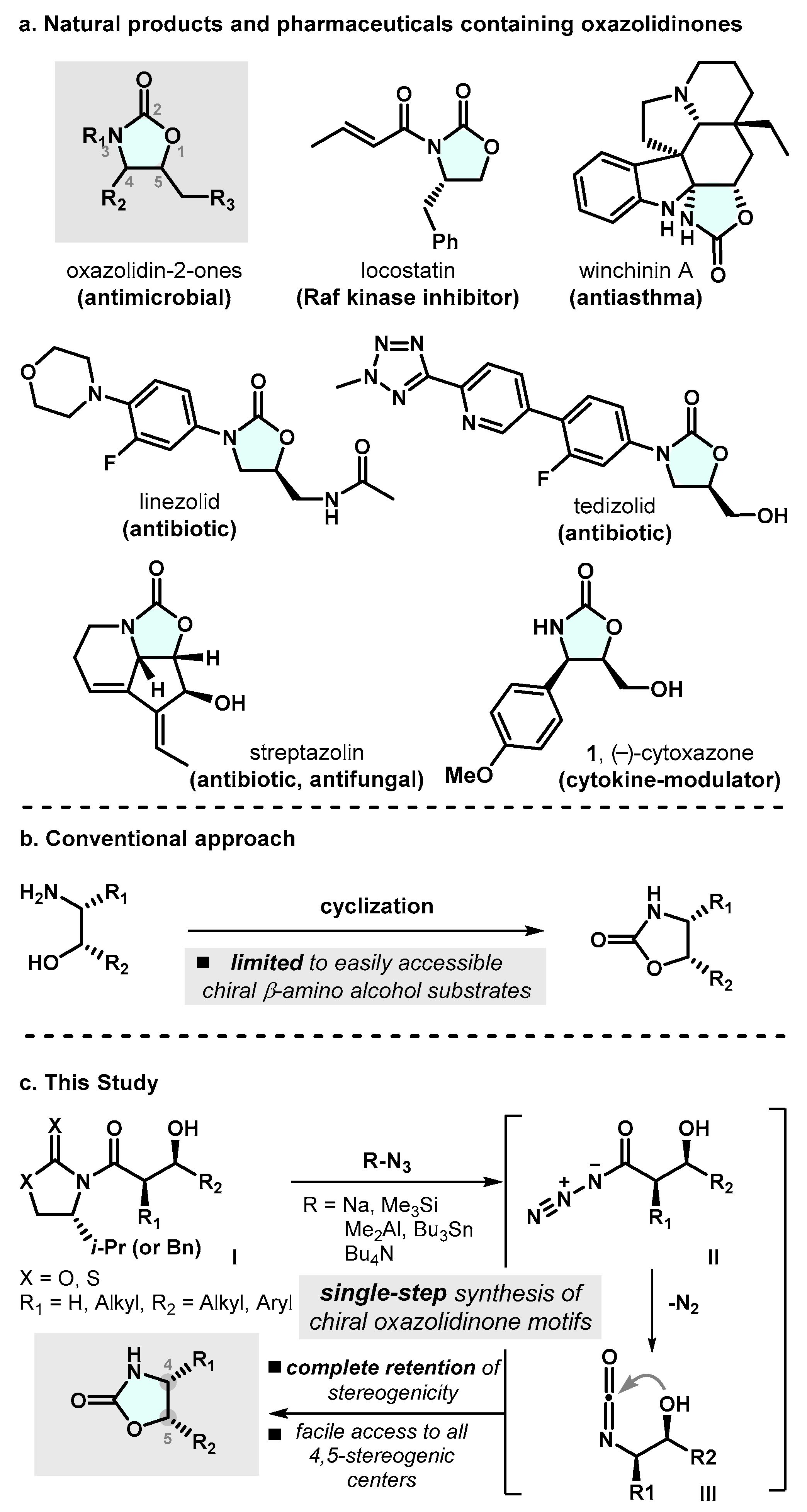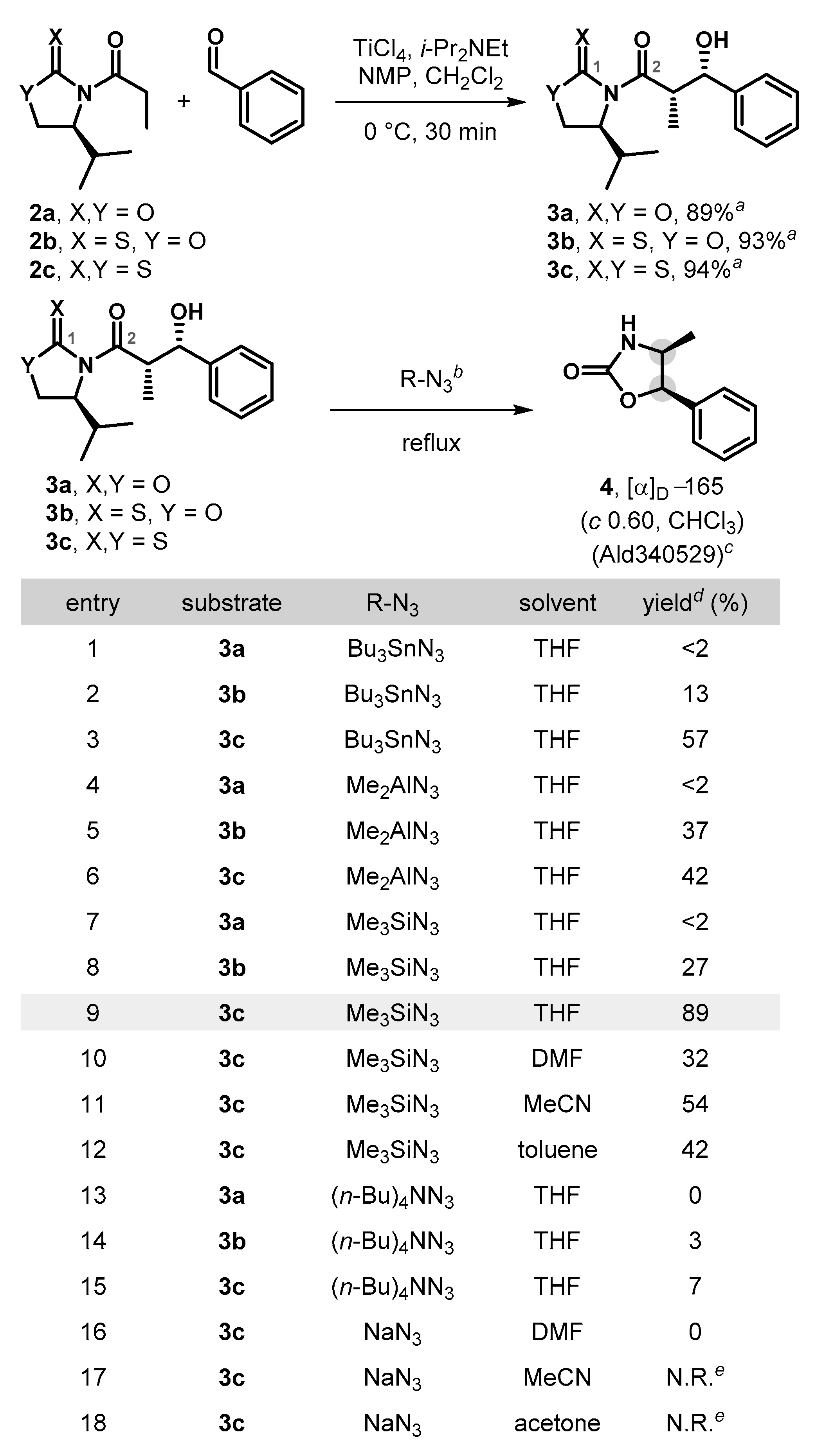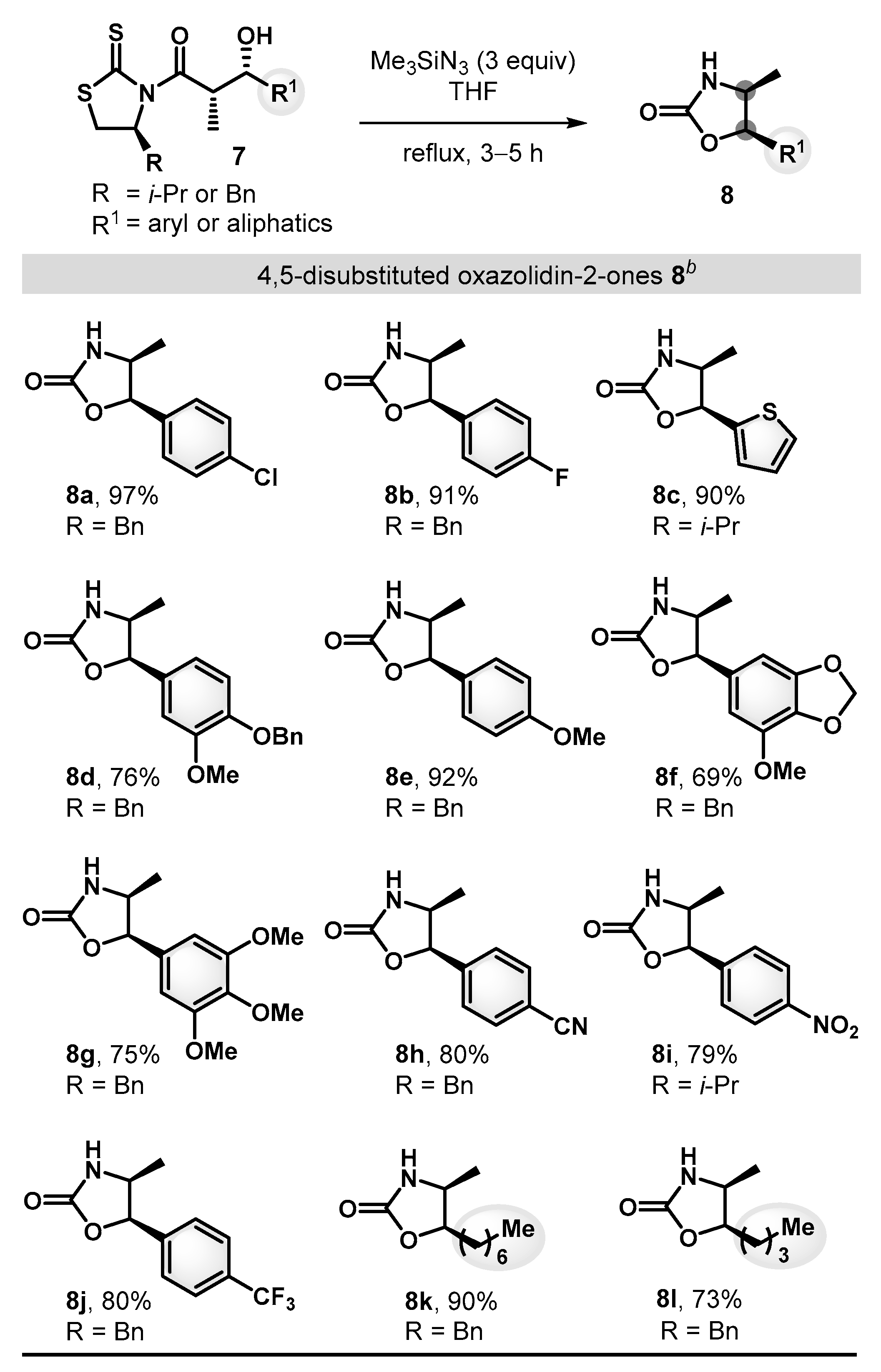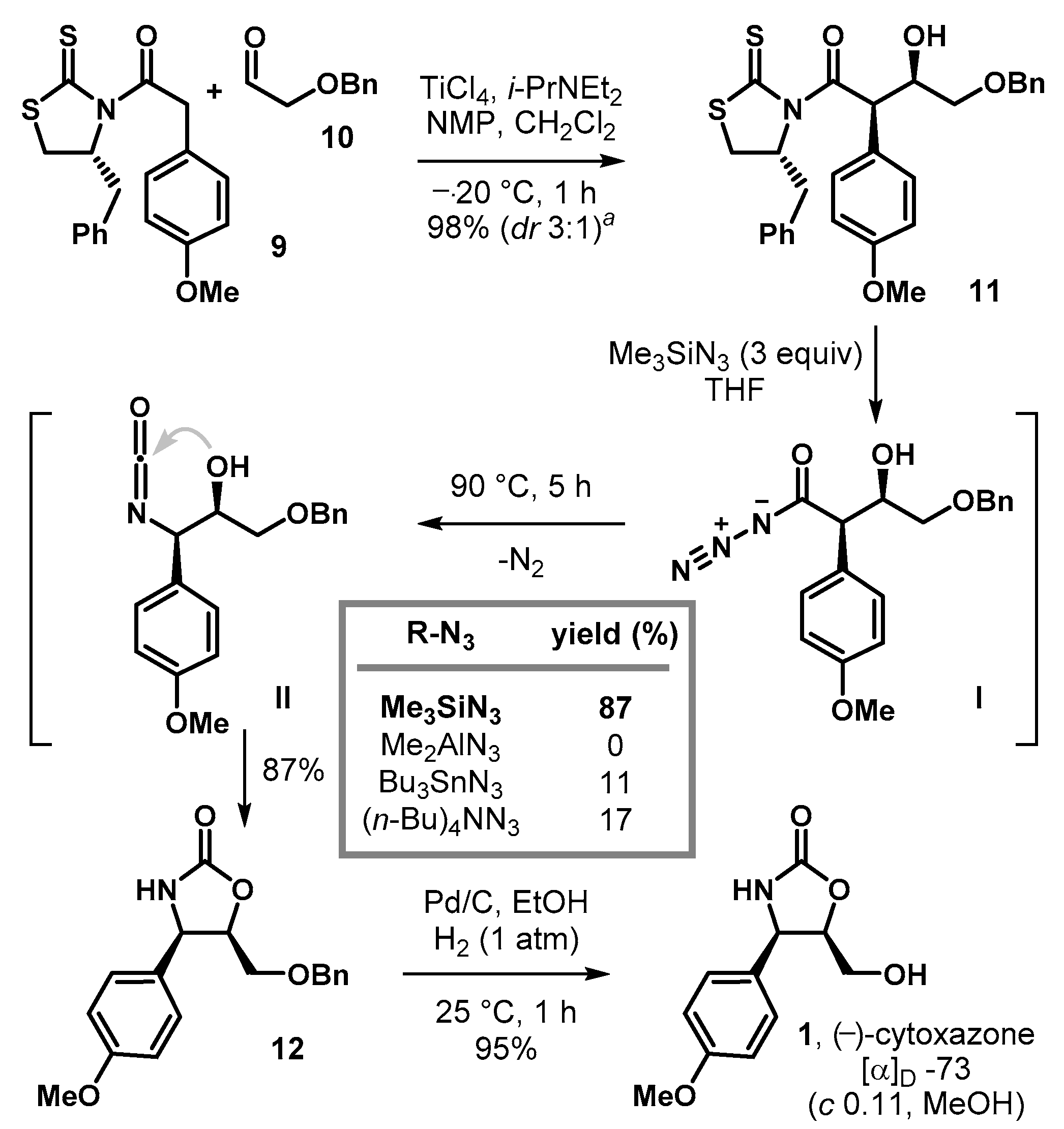Stereoselective Synthesis of Oxazolidin-2-ones via an Asymmetric Aldol/Curtius Reaction: Concise Total Synthesis of (−)-Cytoxazone
Abstract
:1. Introduction
2. Results and Discussion
3. Experimental Section
3.1. General Information
3.2. Representative Procedure for the Synthesis of 4
3.3. Synthesis of Oxazolidin-2-one (8a–8l)
3.4. Synthesis of (–)-Cytoxazone
4. Conclusions
Supplementary Materials
Author Contributions
Funding
Data Availability Statement
Conflicts of Interest
Sample Availability
References
- Slee, A.M.; Wuonola, M.A.; McRipley, R.J.; Zajac, L.; Zawada, M.J.; Bartholomew, P.T.; Gregory, W.A.; Forbes, M. Oxazolidinones, a New Class of Synthetic Antibacterial Agents: In Vitro and In Vivo Activities of DuP 105 and 721. Antimicrob. Agents Chemother. 1987, 31, 1791–1797. [Google Scholar] [CrossRef] [PubMed] [Green Version]
- Muller, M.; Schimz, K.L. Oxazolidinones: A novel class of antibiotics. Cell. Mol. Life Sci. 1999, 56, 280–285. [Google Scholar] [CrossRef] [PubMed]
- Marchese, A.; Schito, G.C. The oxazolidinones as a new family of antimicrobial agent. Clin. Microbiol. Infect. 2001, 7, 66–74. [Google Scholar] [CrossRef] [PubMed] [Green Version]
- Neu, H.C.; Novelli, A.; Saha, G.; Chin, N.X. In Vitro Acticities of Two Oxazolidinone Antimicrobial Agent, DuP 721 and DuP 105. Antimicrobal Agents Chemother. 1988, 32, 580–583. [Google Scholar] [CrossRef] [Green Version]
- Bozdogan, B.; Appelbaum, P.C. Oxazolidinones: Activity, mode of action, and mechanism of resistance. Int. J. Antimicrob. Agents 2004, 23, 113–119. [Google Scholar] [CrossRef]
- Naresh, A.; Rao, M.V.; Kotapalli, S.S.; Ummanni, R.; Rao, B.V. Oxazolidinone derivatives: Cytoxazone-linezolid hybrids induces apoptosis and senescence in DU145 prostate cells. Eur. J. Med. Chem. 2014, 80, 295–307. [Google Scholar] [CrossRef]
- Clemett, D.; Markham, A. Linezolid. Drugs 2000, 59, 815–827. [Google Scholar] [CrossRef]
- Ford, C.W.; Zurenko, G.E.; Barbachyn, M.R. The Discovery of Linezolid, the First Oxazolidinone Antibacterial Agent. Curr. Drug. Targets Infect. Disord. 2001, 1, 181–199. [Google Scholar] [CrossRef]
- Noskin, G.A.; Siddiqui, F.; Stosor, V.; Hacek, D.; Peterson, L.R. In Vitro Activities of Linezolid against Important Gram-positive Bacterial Pathogens Including Vancomycin-Resistant Enterococci. Antimicrob. Agents Chemother. 1999, 43, 2059–2062. [Google Scholar] [CrossRef] [Green Version]
- Burdette, S.D.; Trotman, R. Tedizolid: The first once-daily oxazolidinone class antibiotic. Clin. Infect. Dis. 2015, 61, 1315–1321. [Google Scholar]
- Evans, D.A.; Bartroli, J.; Shih, T.L. Enantioselective Aldol Condensations. 2. Erythro-Selective Chiral Aldol Condensations via Boron Enolates. J. Am. Chem. Soc. 1981, 103, 2127–2129. [Google Scholar] [CrossRef]
- Ager, D.J.; Prakash, I.; Schaad, D.R. 1,2-Amino alcohols and Their Heterocyclic Derivatives as Chiral Auxiliaries in Asymmetric synthesis. Chem. Rev. 1996, 96, 835–875. [Google Scholar] [CrossRef] [PubMed]
- Evans, D.A.; Wu, L.D.; Wiener, J.J.M.; Johnson, J.S.; Ripin, D.H.B.; Tedrow, J.S. A General Method for the Synthesis of Enantiomerically Pure β-Substituted, β-Amino Acids through α-Substituted Succinic Acid Derivatives. J. Org. Chem. 1999, 64, 6411–6417. [Google Scholar] [CrossRef]
- Dinsmore, C.J.; Mercer, S.P. Carboxylation and Mitsunobu Reaction of Amines to Give Carbamates: Retention vs Inversion of Configuration Is Substituent-Dependent. Org. Lett. 2004, 6, 2885–2888. [Google Scholar] [CrossRef]
- Yadav, G.D.; Pawar, S.V. Novelty of immobilized enzymatic synthesis of 3-ethyl-1,3-oxazolidin-2-one using 2-aminoalcohol and dimethyl carbonate: Mechanism and kinetic modeling of consecutive reactions. J. Mol. Catal. B Enzym. 2014, 109, 62–69. [Google Scholar] [CrossRef]
- Beattie, C.; North, M. Mechanistic Investigation of the Reaction of Epoxides with Heterocumulenes Catalysed by a Bimetallic Aluminium Salen Complex. Chem. Eur. J. 2014, 20, 8182–8188. [Google Scholar] [CrossRef]
- Castro-Osma, J.A.; Earlam, A.; Lara-Sánchez, A.; Otero, A.; North, M. Synthesis of Oxazolidinones from Epoxides and Isocyanates Catalysed by Aluminium Heteroscorpionate Complexes. Chem. Cat. Chem. 2016, 8, 2100–2108. [Google Scholar] [CrossRef]
- Fontana, F.; Chen, C.C.; Aggarwal, V.K. Palladium-Catalyzed Insertion of CO2 into Vinylaziridines: New Route to 5-Vinyloxazolidinones. Org. Lett. 2011, 13, 3454–3457. [Google Scholar] [CrossRef]
- Curtius, T. Ueber Stickstoffwasserstoffsäure (Azoimid) N3H. Ber. Dtsch. Chem. Ges. 1890, 23, 3023–3033. [Google Scholar] [CrossRef] [Green Version]
- Curtius, T. Hydrazide und Azide organischer Säuren. J. Prakt. Chem. 1894, 50, 275–294. [Google Scholar] [CrossRef] [Green Version]
- Scriven, E.F.V.; Turnbull, K. Azides: Their preparation and synthetic uses. Chem. Rev. 1988, 88, 297–368. [Google Scholar] [CrossRef]
- Shioiri, T.; Ninomiya, K.; Yamada, S. Diphenylphosphoryl Azide. A New Convenient Reagent for a Modified Curtius Reaction and for the Peptide Synthesis. J. Am. Chem. Soc. 1972, 94, 6203–6205. [Google Scholar] [CrossRef] [PubMed]
- Wolff, O.; Waldvogel, S.R. Reliable Protocol for the Large Scale Synthesis of Diphenylphosphoryl Azide (DPPA). Synthesis 2004, 1303–1305. [Google Scholar]
- Cowden, C.J.; Paterson, I. Asymmetric Aldol Reactions Using Boron Enolates. Org. React. 1997, 51, 1–200. [Google Scholar]
- Nagao, Y.; Kumagai, T.; Yamada, S.; Fujita, E.; Inoue, Y.; Nagase, Y.; Aoyagi, S.; Abe, T. Investigation of New Chiral 1,3- Oxazolidine-2-thiones: Analytical Separation and Optical Resolution of Racemic Carboxylic Acids and Amino Acids. J. Chem. Soc. Perkin Trans. 1 1985, 2361–2367. [Google Scholar] [CrossRef]
- Nagao, Y.; Yamada, S.; Kumagai, T.; Ochiai, M.; Fujita, E. Use of Chiral 1,3-Oxazolidine-2-thiones in the Diastereoselective Synthesis of Aldols. J. Chem. Soc. Chem. Commun. 1985, 1418–1419. [Google Scholar] [CrossRef]
- Crimmins, M.T.; King, B.W.; Tabet, E.A.; Chaudhary, K. Asymmetric Aldol Additions: Use of Titanium Tetrachloride and (−)-Sparteine for the Soft Enolization of N-Acyl Oxazolidinones, Oxazolidinethiones, and Thiazolidinethiones. J. Org. Chem. 2001, 66, 894–902. [Google Scholar] [CrossRef]
- Crimmins, M.T.; She, J. An Improved Procedure for Asymmetric Aldol Additions with N-Acyl Oxazolidinones, Oxazolidinethiones and Thiazolidinethiones. Synlett 2004, 1371–1374. [Google Scholar] [CrossRef] [Green Version]
- Crimmins, M.T.; Chaudhary, K. Titanium Enolates of Thiazolidinethione Chiral Auxiliaries: Versatile Tools for Asymmetric Aldol Additions. Org. Lett. 2000, 2, 775–777. [Google Scholar] [CrossRef]
- Choi, H.; Jang, H.; Kim, H.; Lee, K. Synthesis of γ-Lactones via the Kowalski Homologation Reaction: Protecting-Group-Free Divergent Total Syntheses of Eupomatilones-2,5,6, and 3-epi-Eupomatilone-6. Org. Lett. 2019, 21, 7857–7862. [Google Scholar] [CrossRef]
- Birkofer, L.; Wegner, P. Trimethylsilyl Azide. Org. Synth. 1970, 50, 107. [Google Scholar]
- Kakeya, H.; Morishita, M.; Kobinata, K.; Osono, M.; Ishizuka, M.; Osada, H. Isolation and biological activityof a novel cytokine modulator, cytoxazone. J. Antibiot. 1998, 51, 1126–1128. [Google Scholar] [CrossRef] [PubMed] [Green Version]
- Sakamoto, Y.; Shiraishi, A.; Seonhee, J.; Nakata, T. Stereoselective syntheses of cytoxazone, a novel cytokine modulator, and its stereoisomers. Tetrahedron Lett. 1999, 40, 4203–4206. [Google Scholar] [CrossRef]
- Kakeya, H.; Morishita, H.; Koshino, T.; Morita, K.; Kobayashi, K.; Osada, H. Cytoxazone: A Novel Cytokine Modulator Containing a 2-Oxazolidinone Ring Produced by Streptomyces sp. J. Org. Chem. 1999, 64, 1052–1053. [Google Scholar] [CrossRef] [PubMed]
- Carda, M.; González, F.; Sánchez, R.; Marco, J.A. Stereoselective synthesis of (−)-Cytoxazone. Tetrahedron Asymmetry 2002, 13, 1005–1010. [Google Scholar] [CrossRef]
- Carter, P.H.; LaPorte, J.R.; Scherle, P.A.; Decicco, C.P. A New Synthesis of Cytoxazone and Its Diastereomers Provides Key Initial SAR Information. Bioorg. Med. Chem. Lett. 2003, 13, 1237–1239. [Google Scholar] [CrossRef]
- Boruwa, J.; Borah, J.C.; Kalita, B.; Barua, N.C. Highly regioselective ring opening of epoxides using NaN3: A short and efficient synthesis of (–)-Cytoxazone. Tetrahedron Lett. 2004, 45, 7355–7358. [Google Scholar] [CrossRef]
- Davies, S.G.; Hughes, D.G.; Nicholson, R.L.; Smith, A.D.; Wright, A.J. Asymmetric synthesis of (4R,5R)-cytoxazone and (4R,5S)-epi-cytoxazone. Org. Biomol. Chem. 2004, 2, 1549–1553. [Google Scholar] [CrossRef]
- Venkataramasubramanian, V.; Kiran, I.N.C.; Sudalai, A. Proline-Catalyzed α-Aminooxylation of β-Amino Aldehydes: Access to Enantiomerically Pure syn- and anti-3-Amino-3-aryl-1,2-alkanediols. Synlett 2015, 26, 355–358. [Google Scholar]
- Lingamurthy, M.; Nalliboina, G.R.; Rao, M.V.; Rao, B.V.; Reddy, B.S.; Kumar, H.M.S. DDQ mediated stereoselective intermolecular benzylic CeN bond formation: Synthesis of (−)-cytoxazone, (−)-4-epi-cytoxazone and their analogues and immunological evaluation of their cytokine modulating activity. Tetrahedron 2017, 73, 1473–1481. [Google Scholar] [CrossRef]
- Hidasová, D.; Janák, M.; Jahn, E.; Císařová, I.; Jones, P.G.; Jahn, U. Diastereoselective Radical Couplings Enable the Asymmetric Synthesis of anti-β-Amino-α-hydroxy Carboxylic Acid Derivatives. Eur. J. Org. Chem. 2018, 5222–5230. [Google Scholar] [CrossRef]





Publisher’s Note: MDPI stays neutral with regard to jurisdictional claims in published maps and institutional affiliations. |
© 2021 by the authors. Licensee MDPI, Basel, Switzerland. This article is an open access article distributed under the terms and conditions of the Creative Commons Attribution (CC BY) license (http://creativecommons.org/licenses/by/4.0/).
Share and Cite
Choi, H.; Jang, H.; Choi, J.; Lee, K. Stereoselective Synthesis of Oxazolidin-2-ones via an Asymmetric Aldol/Curtius Reaction: Concise Total Synthesis of (−)-Cytoxazone. Molecules 2021, 26, 597. https://doi.org/10.3390/molecules26030597
Choi H, Jang H, Choi J, Lee K. Stereoselective Synthesis of Oxazolidin-2-ones via an Asymmetric Aldol/Curtius Reaction: Concise Total Synthesis of (−)-Cytoxazone. Molecules. 2021; 26(3):597. https://doi.org/10.3390/molecules26030597
Chicago/Turabian StyleChoi, Hosam, Hanho Jang, Joohee Choi, and Kiyoun Lee. 2021. "Stereoselective Synthesis of Oxazolidin-2-ones via an Asymmetric Aldol/Curtius Reaction: Concise Total Synthesis of (−)-Cytoxazone" Molecules 26, no. 3: 597. https://doi.org/10.3390/molecules26030597
APA StyleChoi, H., Jang, H., Choi, J., & Lee, K. (2021). Stereoselective Synthesis of Oxazolidin-2-ones via an Asymmetric Aldol/Curtius Reaction: Concise Total Synthesis of (−)-Cytoxazone. Molecules, 26(3), 597. https://doi.org/10.3390/molecules26030597





